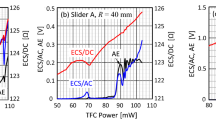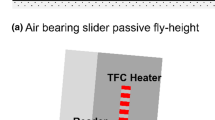Abstract
The quantitative analysis of lubricant transferred from disk to slider is important in understanding the interaction in head-disk interface and designing a stable head-disk system. When applying ellipsometric technology to determine the lubricant thickness on slider, the measurement accuracy is of concern due to the location-to-location variations of slider optical constants. This paper carried out a systematic and quantitative study on how the variations of slider optical constants affect the measurement accuracy of lubricant thickness. In this study, the distribution of slider optical constant was obtained; a differential method was used to calculate the uncertainty in lubricant thickness and the calculated results were experimentally verified. The results show that for the state-of-art sliders, the uncertainty in lubricant thickness is about 20 % for below 2 nm thicknesses and less than 15 % for around 3 nm thicknesses when measured at 632.8 nm wavelength. The results of this study might be also useful for the other optical instruments used to determine the amount of the transferred lubricant.








Similar content being viewed by others
References
Ambeka RP, Bogy DB (2008) Critical clearance and lubricant instability at the head-disk interface of a disk drive. Appl Phys Lett 92:033104
Chiba H, Ogata S (2008) Quantitative analysis of lubricant pick-up at ultra-low flying height. The digest of TMRC 2008, BC-1(invited talk)
J. A. Woollam Co., Inc (2000) Guide to Using WVASE32®
Kim SH, Dai Q, Marchon B, Flechsig K (2009) Humidity effects on lubricant transfer in the head-disk interface of a head disk drive. J Appl Phys 105:07B704
Leavitt PK (1992) Determination of lubricant thickness on magnetic recording heads using XPS. Surf Interface Anal 18:387–391
Tani H, Kubota M, Tsujiguchi Y, Tagawa N (2011) Visualization of lubricant pickup phenomena by lubricant thickness mapping on slider surface. Microsyst Technol 17(5-7):1175–1178
Tompkins HG, McGahan WA (1999) Spectroscopic Ellipsometry and Reflectometry: a User’s Guide. John Wiley and Sons Inc, New York
Yanagisawa K, Watanabe T, Kawakubo Y, Yoshina M (2010) Thickness change in molecularly thin lubricant under flying head in hard disk drive. Tribol Lett 40(1):99–103
Yuan ZM, Ong CL, Leong SH, Liu B, Liu J, Yoshuda S (2008) Slider optical constant distribution, n and k correlation, and FH measurement accuracy. IEEE Trans Magn 44(1):3687–3690
Author information
Authors and Affiliations
Corresponding author
Rights and permissions
About this article
Cite this article
Zhao, J.M., Zhang, M.S., Yang, M.C. et al. Ellipsometric measurement accuracy of ultrathin lubricant thickness on magnetic head slider. Microsyst Technol 18, 1283–1288 (2012). https://doi.org/10.1007/s00542-012-1519-8
Received:
Accepted:
Published:
Issue Date:
DOI: https://doi.org/10.1007/s00542-012-1519-8




